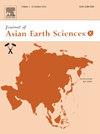弱反射地质界面反演的迭代自然阈值算法
IF 2.3
Q3 GEOSCIENCES, MULTIDISCIPLINARY
引用次数: 0
摘要
地震反演已发展成为勘探地球物理中地下岩石弹性性质定量预测的核心技术。在实际应用中,地震阻抗反演是一种常用的技术。但在实际地震资料中对小反射率序列的保护效果仍不理想。这些小反射率序列对应于地质界面的弱反射,通常是隧道工程或石油工程中的油气储层等具有地质意义的地层的低声阻抗对比的标志。因此,从原始地震资料中恢复它们是非常重要和有意义的。本文采用迭代自然阈值算法(INTA)来提高对弱反射的保护。通过最优阈值算子和凹正则化来实现最优稀疏解,INTA可以潜在地恢复这些以弱反射为特征的地质界面。利用合成地震资料剖面和实际地震资料集验证了该方法的可行性,并证明了该方法对小反射率序列具有较好的保护作用。从反演结果可以看出,与常用的稀疏约束地震反演方法相比,本文方法的反演阻抗能更好地表征弱反射体,有助于更准确地了解地球结构。本文章由计算机程序翻译,如有差异,请以英文原文为准。
Iterative natural thresholding algorithm for seismic inversion aimed at potentially recovering geological interfaces characterized by weak reflection
Seismic inversion has developed into the core technology of quantitative prediction of rock’s elastic properties of underground in the exploration geophysics. In practical application, seismic impedance inversion is a frequently utilized technique. But it still has unsatisfactory protection of small reflectivity series in real seismic data. These small reflectivity series correspond to the weak reflections of geological interfaces, which is usually a sign of low acoustic impedance contrast in tunnels engineering or reservoirs of oil and gas in petroleum engineering, and other strata of geological significance. Hence, it is very important and meaningful to recover them from original seismic data. This paper adopts a novel algorithm named iterative natural thresholding algorithm (INTA) with the aim to improve the protection of weak reflections. Through an optimal thresholding operator and a concave regularization to enforce an optimal sparse solution, INTA can potentially recover these geological interfaces characterized by weak reflection. We utilize a synthetic seismic data profile and a real seismic data set to test its feasibility and show its better protection of small reflectivity series. From the inversion results, one can see that, compared to common used sparse constrained seismic inversion method, the inverted impedance by the proposed method can better characterize weak reflectors and help understand the structure of the earth more accurately.
求助全文
通过发布文献求助,成功后即可免费获取论文全文。
去求助
来源期刊

Journal of Asian Earth Sciences: X
Earth and Planetary Sciences-Earth-Surface Processes
CiteScore
3.40
自引率
0.00%
发文量
53
审稿时长
28 weeks
 求助内容:
求助内容: 应助结果提醒方式:
应助结果提醒方式:


